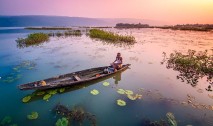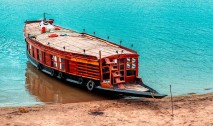Livestock Resources
Livestock and poultry, being an essential element of integrated farming system, play an important role in the economy of the Haor area. Livestock provides significant draft power for cultivation, threshing and crushing of oil seeds; cow dung as a source of manure and fuel; a ready source of funds; and meat, milk and eggs for human consumption. A large number of livestock are reared in Haor areas but constrained by flash flood causing inundation of large areas during most of the time in the year. This area is famous for duck rearing due to availability of natural feed for ducks in natural large water bodies. All of livestock species suffer much due to shortage of feed, outbreak of waterborne diseases and inadequate shelter facilities. The livestock rearer in the Haor areas do not get fair price due to poor communication as well as lack of marketing facilities.
The indicator status of livestock has been selected for assessing the impact of the project. The status of livestock population data were collected from Livestock Census (1986), Agriculture census (1996 and 2008) of BBS. The status of livestock feed and fodder, diseases, marketing facilities information were gathered from stakeholders through Focus Group Discussion (FGD) and Key Informant Interview (KII).
Status of Livestock Population, Feed and Diseases
Our Objectives
The perennial availability of water in the rivers and Haor provides critical sources of income and nutrition for millions of rural Bangladesh’s poorest people. Cap Foundation’s aim is to deliver 1000 boats to the flood ridden destitute families who are struggling to survive financially to manage their livelihood and sustain a family income. The fallout has been devastating, both on a humanitarian and spiritual level. Today, millions of refugees lack access to the most basic necessities needed for daily survival.
Coverage
Bangladesh | Nethrokuna District | Sunamgonj District | Hobigonj District | Moulvibazar District and Kishorgonj District.
The entire Sunamganj district, major portion of Habiganj district, some parts of Sylhet Sadar upazila and Maulvi Bazar district are covered by many haors. In greater Sylhet the most prominent haors are Saneer haor, Hail haor, Hakaluki haor, Dekar haor, Maker haor, Chayer haor, Tangur haor and Kawadighi haor.
Reporting & Evaluation
We have devised a report writing tool for the filed officer’s to monitor the progression of their livelihood and measure success rate by focusing on the following areas:
- Improvement of living conditions of the property stricken
- Progress of children’s education due to enabling transport
- Future savings and investments
- Transformation of lifestyle and impact made
- Creating case studies that demonstrate the success of this project
The above method is used to evaluate project outcome and success.
You Can Contribute to:
- Donate towards a full Boat package include; a boat, all fishing material and a life jacket – only £300
- Donate towards research and reporting
“GIVE A MAN A FISH YOU FEED HIM FOR A DAY, TEACH HIM TO FISH YOU FEED A FAMILY FOR LIFE”…

Pre Project
According to livestock census 1996, the livestock and poultry population in the project area were 3,150 cattle, 570 goats, 8,570 chicken and 6,540 ducks (Table 5.1). Before implementation of the project, the major feed available to ruminants was mostly crop residues (rice straw) supplemented with weeds from cultivated fields. They are to depend on naturally grown grasses in Kandas and alongside roads and embankments. Most of the year before implementation of the project, the crops were to damage by early flash flood. As a result, shortage of feed from crop residues, reduction of grazing facilities seriously affect livestock rearing. That time, the small holders were to depend on water hyacinth and other aquatic plant for their cattle. The major poultry feeds were rice bran, broken rice, kitchen wastes like rice, rice-gruel, vegetables, fish wastes etc. In addition, the duck usually scavenge in the nearby water bodies like Haor, beel, khal, river or any other low lying areas; mainly eat various types of aquatic insects, small fish, shell or snails. Major livestock and poultry diseases were Gola Phula (Haemorragic Septicemia), Pox and Cholera, Duck cholera, Newcastle and Fowl cholera etc. in the project area. The most vulnerable period was between July to November for spreading diseases to livestock and poultry populations. Mortality rate of the livestock/poultry was higher due to poor shelter condition and they lived in unhygienic condition. Marketing facilities was not in good condition and price was also low due to less demand of their products and by products. Producer consumed their products at family level and additional products were sold at local village market.


Post Project
According to agriculture census 2008, the livestock and poultry population in the project area are 6,580 cattle, 720 goats, 13,970chicken and 9,630ducks (Table 5.1). After implementation of the project, crop is protected from early flash flood. As a result, the feed availability of livestock is increased due to increase of crop production. However, some of the year, the crops were damaged by early flash flood. In that year, the small holders were dependent on water hyacinth and other aquatic plant for their cattle. The poultry feeds are same as in pre project situation. On the other hand, more or less similar diseases are found in post project situation. The mortality rate of the livestock/poultry became negligible during the project period, due to extension works at farmers’ level such as immunization and insemination program by Department of Livestock (DLS). Marketing facilities during dry season also improved due to improvement of the communication system by constructing the submersible embankments. Therefore, market prices are increased due to high demand of products and by products.
HAOR INFRASTRUCTURE AND LIVELIHOOD IMPROVEMENT PROJECT (HILIP)
The project has been covering the poor households living in the Haor basin, having less than 2.5 acres of land. HILIP also covers small fishing households deriving a major share of their income from fishing. Among all the Fisheries is a very challenging component to the project. The component has a plan to access 500 waterbodies of different sizes and bring those under community based sustainable resource management.

Impact
From 1996 to 2008, about 3,430 cattle have increased due to the reduction of flood vulnerability, improvement of marketing facilities and strengthening of livestock extension services. On the other hand, the goat, chicken and duck population has been increased to 150, 5,400 and 3,090 respectively.
The mobile duck farms in the haors
In the extreme conditions of the haors, farmers have devised an ingenious method to set up mobile duck farms that are sustained largely by the environment itself.

Abundant natural resources have made haors a suitable place for duck farming. PHOTO: ASHRAFUL HAQUE
We were travelling from Austagram to Mithamain through the all-season road that pierces the vast haors of Kishoreganj. The sun had appeared on the right hand side of the road a while ago, and people were already busy doing their things.
Haor is a strange place where two extremities converge. During the dry season, from November to April, you'll only see open fields to the horizon and beyond. And during the rest of the year, the whole place turns into a sea of freshwater. Rising waters inundate the croplands and the difference between canals, rivers, and beels wither away.
Five kilometres away from Austagram, in the middle of the Vatshala Haor, something interesting caught my eyes and interrupted my thoughts.
I have seen duck farms before, but never saw something like this. After a while, we found ourselves on a boat, heading towards the farmhouse.
There were 1,200 ducks in the farm. The fence was put up in order to restrain them from swimming away. It is not required in the dry land, because, as Kalam pointed out, "it is easy to control the ducks on the land. They do not move much once they are fed.
There was also a shed for the ducks in the backyard, which was not submerged. The farmers will move this shed to the new place in the dry season. The 'island' was 20 decimal, and the netted front was about 15 decimal. The house was built just eight months back.

PHOTO: ASHRAFUL HAQUE
"During this time they feed on a variety of aquatic plants and grasses, invertebrates, fish - all naturally found in the haor," said Nomoj Kha, another duck farmer from Austagram. Nomoj has 2,500 ducks in his farm. His brother has another 1,400 ducks.








